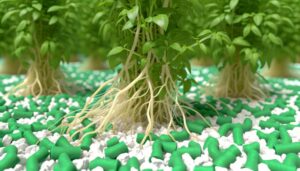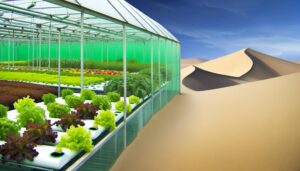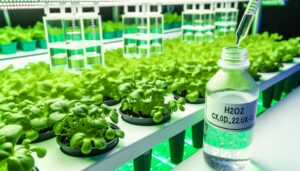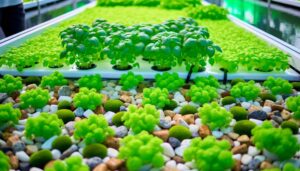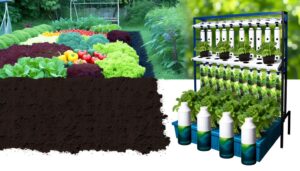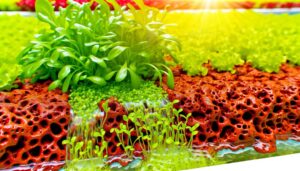How to Use a Hydroponic Tower
Using a hydroponic tower requires careful selection and assembly of components to guarantee ideal plant growth. Start by choosing a tower suited to your space and crop requirements, making sure it is built of food-safe materials.
Gather essential materials such as a high-quality nutrient solution, a reliable water pump, and a pH meter. Assemble the tower step-by-step, securing each component firmly.
Select plants with compatible growth cycles and light needs, and prepare a balanced nutrient solution. Monitor pH and EC levels, adjusting light conditions for ideal photosynthesis.
Follow regular maintenance schedules and troubleshoot common issues to maintain the system's efficiency. To master every detail, there's much more to discover.
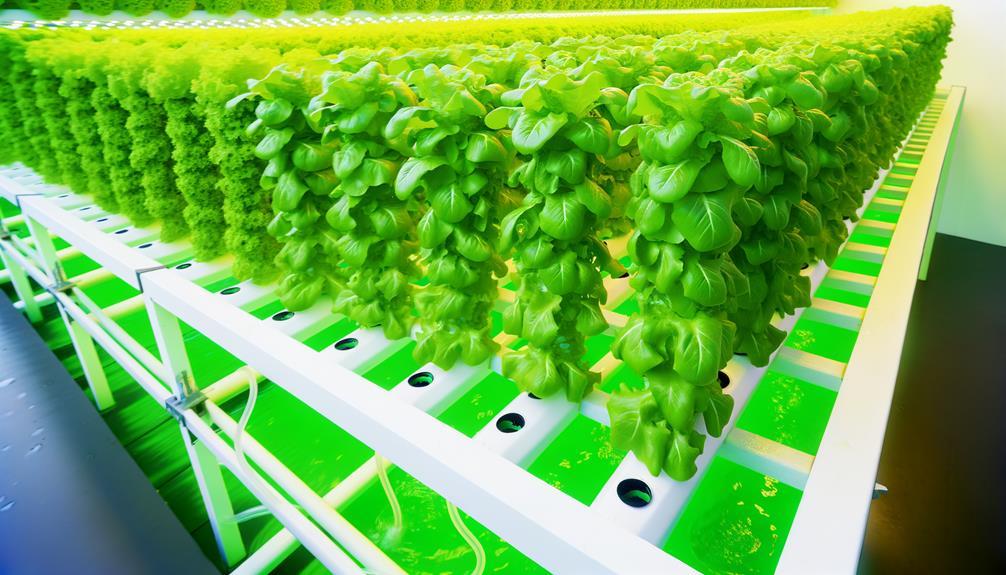
Key Takeaways
- Choose the right tower size and system complexity based on available space and crop requirements.
- Assemble the tower following step-by-step instructions, ensuring all components are securely attached.
- Prepare a balanced nutrient solution, adjust pH to 5.5-6.5, and ensure proper mixing.
- Select plants with shallow root structures and similar growth cycles to optimize space and maintenance.
Choosing the Right Tower
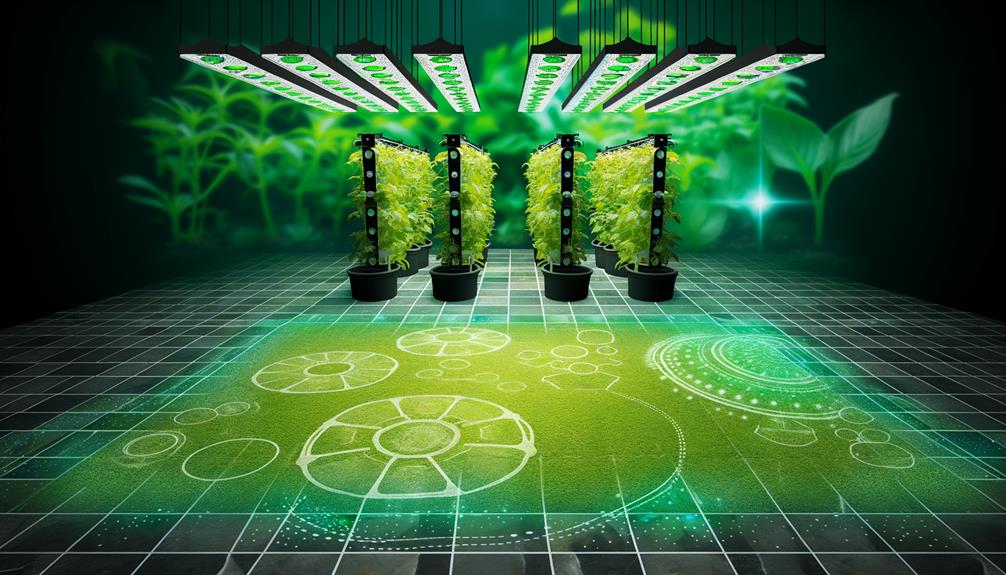
Selecting the appropriate hydroponic tower requires careful consideration of factors such as available space, crop type, and system complexity.
Evaluate the dimensions of your growing area to make sure the tower fits without overcrowding. Different crops have varying spatial and nutritional needs; leafy greens thrive in smaller towers, while fruiting plants may necessitate larger, sturdier systems.
Assess the complexity of the system: passive systems like wicking towers are simpler but less efficient for nutrient uptake, whereas active systems such as aeroponics offer superior growth rates but demand more maintenance and technical knowledge.
Additionally, consider the materials used in construction, making certain they are food-safe and durable.
Proper selection enhances productivity and aligns with specific cultivation goals.
Required Materials
To set up a hydroponic tower, one must gather essential materials that include a high-quality nutrient solution, appropriate growing medium, and a reliable water pump system. These components work together to ensure plants receive adequate nutrients and water for optimal growth. It is also important to understand how to use hydroponic net pots, as they provide proper support for plant roots while allowing nutrient-rich water to circulate efficiently. Regular maintenance of the system, including checking pH levels and ensuring the water pump functions properly, will help sustain healthy plant growth.
The nutrient solution should be specifically formulated for hydroponic use, containing a balanced mix of macro and micronutrients.
Selecting an appropriate growing medium, such as rock wool, clay pellets, or coco coir, guarantees ideal root support and aeration.
A dependable water pump system is vital for maintaining consistent nutrient circulation; submersible pumps with adjustable flow rates are highly recommended.
Additional necessary materials include pH and EC meters for monitoring nutrient solution parameters, timers for regulating pump cycles, and grow lights if natural sunlight is insufficient.
Proper preparation guarantees a thriving hydroponic environment.
Assembling Your Tower
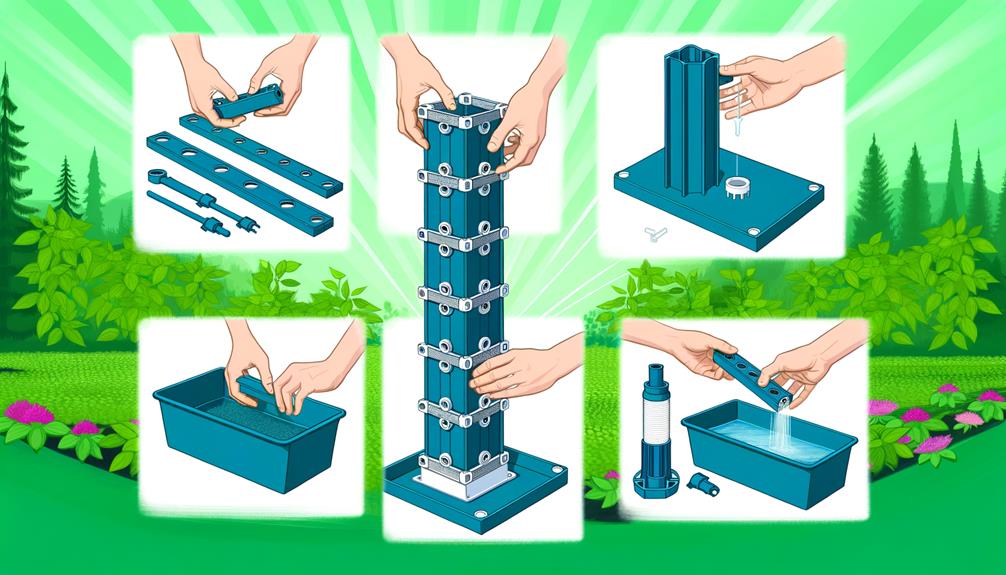
To begin assembling your hydroponic tower, first guarantee that all necessary tools, such as a screwdriver, wrench, and pliers, are readily accessible.
Adhere to the step-by-step instructions provided by the manufacturer, meticulously following each directive to maintain structural integrity.
Gather Necessary Tools
Ascertaining you have all necessary tools and equipment before commencing the assembly of your hydroponic tower is paramount for a seamless and efficient setup process. Adequate preparation mitigates potential disruptions and ascertains a streamlined workflow. Below is a table outlining essential tools and their respective purposes:
| Tool | Purpose |
|---|---|
| Screwdriver | Assembling various tower components |
| Adjustable Wrench | Tightening nuts and bolts |
| Utility Knife | Trimming tubing and cutting materials |
To further elaborate, ascertain the screwdriver is compatible with the screws provided with your hydroponic tower kit. The adjustable wrench should accommodate a range of bolt sizes, ascertaining every connection is secure. A utility knife with a sharp blade aids in precise cuts, ascertaining the tubing fits snugly within the system. Properly gathering these tools will facilitate an efficient and effective assembly process.
Follow Step-by-Step Instructions
Commence the assembly of your hydroponic tower by laying out all components in a well-organized manner to facilitate an efficient and methodical construction process.
Begin by identifying the base unit, which typically contains the reservoir for nutrient solutions. Secure the central support column to the base, guaranteeing it is vertically stable.
Next, attach the growth modules or tiers sequentially, starting from the bottom. Ascertain each module locks securely into place, maintaining alignment.
Insert the nutrient delivery system, which may include tubing and a pump, making sure it reaches all growth modules. Double-check all connections for proper fitment.
Secure Each Component
With the preliminary assembly complete, it is imperative to meticulously secure each component to guarantee the hydroponic tower's structural integrity and functionality.
Begin by ensuring the base is firmly attached to the reservoir, using stainless steel screws for corrosion resistance. Next, align the vertical columns precisely, fastening them with high-tensile bolts.
Confirm that the nutrient delivery tubing is tightly connected to avoid any leakage. Employ waterproof seals around the joints to prevent water seepage.
Attach the grow cups securely within their designated slots, ensuring they are level.
Finally, double-check all electrical connections for the pump and lighting system, ensuring they are insulated and fastened properly.
This thorough inspection will enhance the durability and performance of your hydroponic tower.
Selecting Plants
When selecting plants for your hydroponic tower, it is essential to choose species that thrive in a soilless environment and have compatible growth requirements.
Consider the following factors to guarantee ideal plant selection:
- Root Structure: Opt for plants with shallow root systems, such as lettuce or herbs, which are well-suited to hydroponic setups.
- Growth Cycle: Select species with similar growth cycles to guarantee uniform nutrient absorption and maintenance schedules.
- Light Requirements: Choose plants with compatible light requirements to maximize efficiency in your lighting setup.
- Plant Size: Confirm the mature size of the plants fits within the spatial constraints of your tower, avoiding overcrowding and confirming adequate air circulation.
Adhering to these criteria will promote a successful and productive hydroponic system.
Preparing Nutrient Solution
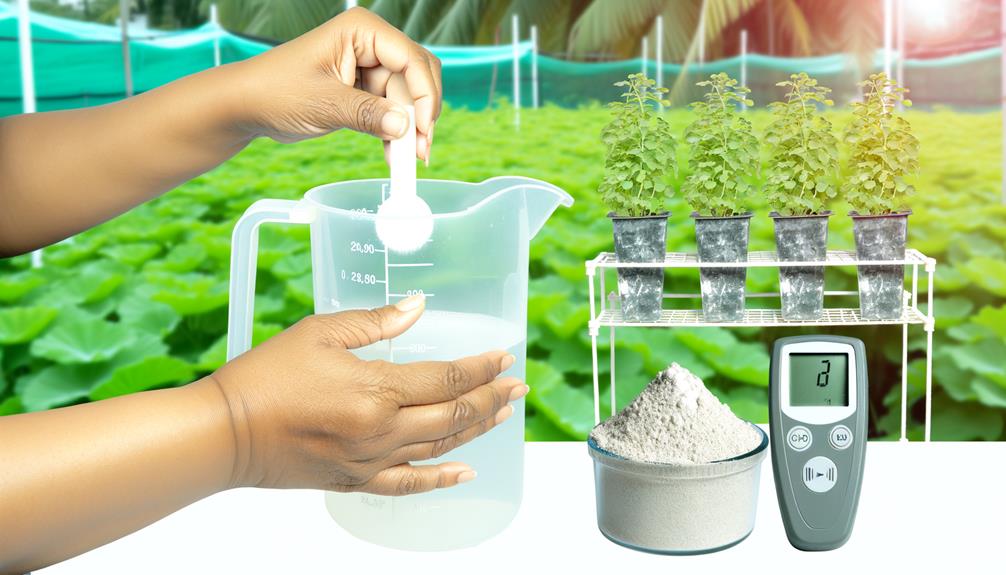
Preparing an effective nutrient solution is essential for optimizing plant growth in a hydroponic tower system.
Start by selecting high-quality, balanced nutrient formulations specifically designed for hydroponics, ensuring they contain essential macro and micronutrients.
Accurately mix the nutrients with water according to manufacturer guidelines, and store the solution in a cool, dark place to maintain its efficacy and prevent contamination.
Choosing Quality Nutrients
Selecting high-quality nutrients is essential for optimizing the growth and health of plants in a hydroponic tower system. The right nutrient mix guarantees that plants receive the necessary macro and micronutrients for robust development.
When choosing nutrient solutions, consider the following critical factors:
- Nutrient Composition: Confirm the solution contains balanced levels of nitrogen (N), phosphorus (P), and potassium (K), along with essential trace elements like iron, magnesium, and calcium.
- Solubility: Opt for nutrients that are highly soluble to prevent clogging in the system and guarantee even distribution.
- pH Stability: Select nutrients formulated to maintain a stable pH to avoid fluctuations that could hinder nutrient uptake.
- Purity: Use nutrients free from contaminants and heavy metals to protect both plant health and consumer safety.
Mixing Solution Properly
After selecting high-quality nutrients, the next step involves accurately mixing the solution to guarantee perfect nutrient availability and plant uptake.
Begin by measuring the required amount of each nutrient component, adhering strictly to the manufacturer's guidelines. Utilize a clean, graduated container for precision.
Dissolve each component separately in water before combining them to prevent undesirable chemical reactions. Use distilled or deionized water to avoid contamination.
Employ an electronic pH meter to adjust the solution's pH to the ideal range, typically between 5.5 and 6.5. Add pH up or pH down solutions incrementally, rechecking after each adjustment.
Agitate the mixture thoroughly to ensure homogeneity. Regularly calibrate your measuring equipment to maintain consistency in nutrient solution preparation.
Storing Nutrient Solution
Guaranteeing the longevity and efficacy of your nutrient solution necessitates proper storage techniques to maintain its chemical stability and prevent degradation. To optimize storage conditions, consider the following:
- Temperature Control: Maintain the nutrient solution at a consistent temperature between 65°F and 75°F to prevent microbial growth and preserve nutrient integrity.
- Light Exposure: Store the solution in an opaque, UV-resistant container to minimize light exposure, which can degrade certain nutrients and promote algae growth.
- Aeration: Implement an aeration system or periodically agitate the solution to prevent stagnation and guarantee an even distribution of nutrients.
- Cleanliness: Regularly clean storage containers to eliminate residual deposits and potential contaminants, thereby preserving the solution's purity and effectiveness.
These measures guarantee your nutrient solution remains viable and effective for hydroponic use.
Planting Seeds or Seedlings
When planting seeds or seedlings in a hydroponic tower, it is crucial to carefully insert them into the growing medium to guarantee proper root development and nutrient absorption.
Begin by selecting a sterile, high-quality growing medium such as rockwool or coco coir. Moisten the medium thoroughly to enhance seed germination or seedling establishment.
Create a small depression in the medium for each seed or seedling, making sure it is adequately spaced to prevent overcrowding. Gently place the seed or seedling into the depression, covering it lightly with the growing medium. Avoid excessive compaction to maintain ideal aeration and water retention.
Setting Up the Water Pump
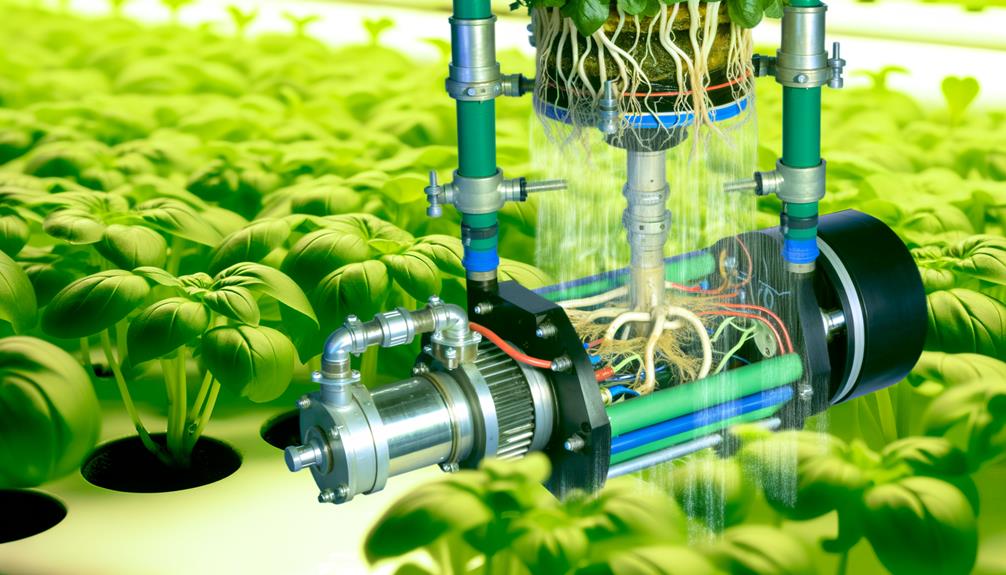
To guarantee ideal functionality of your hydroponic tower, it is essential to select a water pump with the appropriate flow rate and head height specifications.
Proper installation involves securely attaching the pump to the reservoir and verifying all tubing connections are airtight to prevent leaks.
Selecting Pump Size
Selecting the appropriate pump size for your hydroponic tower involves calculating the system's total flow rate and head height to guarantee peak nutrient delivery to your plants.
The following steps outline the critical considerations for selecting the ideal pump:
- Determine Flow Rate: Calculate the total volume of water required per hour, typically measured in gallons per hour (GPH). This guarantees sufficient nutrient solution circulation.
- Calculate Head Height: Measure the vertical distance from the water reservoir to the highest point in the tower, accounting for any bends in piping.
- Pump Efficiency: Choose a pump with a flow rate that meets or exceeds your calculated requirements while operating efficiently at the desired head height.
- Safety Margins: Select a pump with a slightly higher capacity to accommodate potential system expansions or unforeseen pressure losses.
Installing Pump Correctly
Proper installation of the water pump is essential to guarantee peak performance and longevity of your hydroponic tower system. Begin by selecting a pump with the appropriate flow rate and head height, confirming it matches the specific requirements of your tower. Secure the pump in the reservoir, making sure it is fully submerged but not obstructed by debris. Connect the tubing to the pump outlet, ensuring a watertight seal. Route the tubing to the top of the tower, avoiding sharp bends to maintain ideal flow.
| Installation Step | Key Considerations |
|---|---|
| Select Appropriate Pump | Match flow rate and head height to system needs |
| Secure Pump in Reservoir | Ensure full submersion and debris-free environment |
| Connect Tubing | Ensure watertight seal at the pump outlet |
| Route Tubing | Avoid sharp bends for ideal water flow |
| Test System | Verify pump operation and water distribution |
Testing the system verifies proper water distribution and pump functionality.
Adjusting Light Conditions
Guaranteeing ideal light conditions involves calibrating the intensity, duration, and spectrum of light to meet the specific requirements of the plants in your hydroponic tower. Proper light management is essential for photosynthesis and overall plant health.
Here are four key steps to optimize light conditions:
- Light Intensity: Use a light meter to measure and adjust the luminosity, aiming for 400-700 µmol/m²/s, depending on plant type.
- Light Duration: Implement a photoperiod of 14-16 hours per day for most vegetables, using a timer for consistency.
- Light Spectrum: Employ full-spectrum LED grow lights to provide a balanced range of wavelengths, vital for various growth stages.
- Light Positioning: Adjust the height and angle of the lights to guarantee even distribution and minimize shadowed areas.
Monitoring Growth
To accurately monitor growth in a hydroponic tower, consistently measure and record key parameters such as pH levels, nutrient concentrations, and plant height.
Utilize a calibrated pH meter to guarantee the solution maintains an ideal range, typically between 5.5 and 6.5, to facilitate nutrient uptake.
Employ an electrical conductivity (EC) meter to track nutrient concentration, aiming for specific ranges contingent on plant species.
Regularly measure plant height and document growth rates to identify developmental trends and potential issues.
Automated data logging systems can enhance precision and ease of tracking.
Regular Maintenance
Consistent upkeep of a hydroponic tower entails routine inspection and cleaning of components such as pumps, tubing, and growing medium to prevent clogging and guarantee peak system performance. Proper maintenance guarantees efficient nutrient delivery and ideal plant growth.
Regular checks should include:
- Pump Maintenance: Inspect and clean the pump bi-weekly to remove debris and prevent mechanical failures.
- Tubing Inspection: Examine tubing for blockages or algae buildup; clean monthly to guarantee unobstructed nutrient flow.
- Growing Medium Replacement: Replace the growing medium periodically to avoid salt accumulation and nutrient imbalances.
- Reservoir Cleaning: Sanitize the reservoir at least once a month to prevent pathogen proliferation and maintain nutrient solution purity.
Adhering to these practices will sustain a high-functioning hydroponic system.
Troubleshooting Common Issues
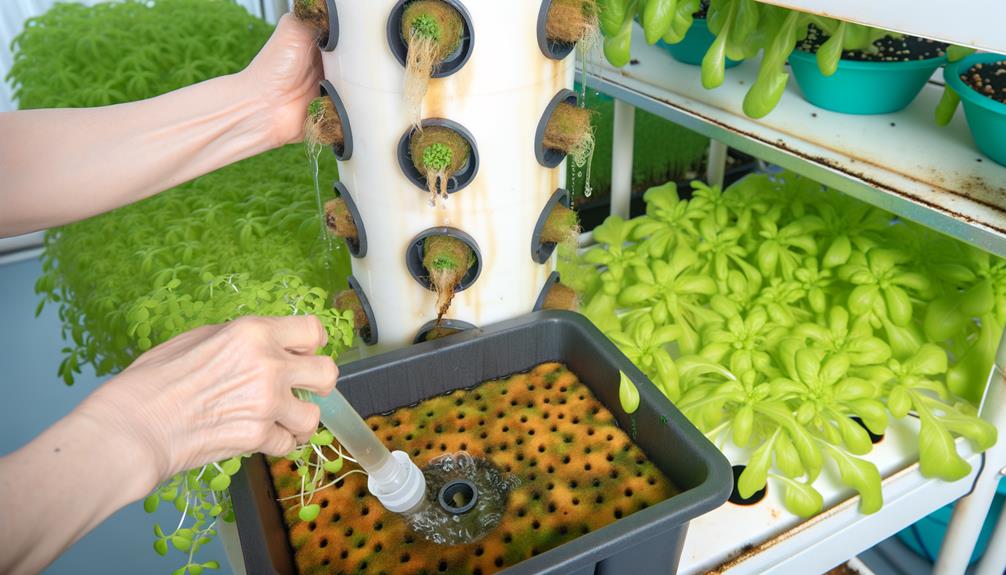
Despite meticulous maintenance, hydroponic towers can still encounter issues such as nutrient deficiencies, pH imbalances, and pest infestations, necessitating adept troubleshooting to sustain peak plant health. To address these problems, it is vital to monitor system parameters regularly and employ corrective measures promptly. For example, nutrient deficiencies can be rectified by adjusting the nutrient solution concentration.
| Issue | Solution |
|---|---|
| Nutrient Deficiencies | Adjust nutrient solution concentration |
| pH Imbalances | Use pH up/down solutions to stabilize pH levels |
| Pest Infestations | Employ organic pesticides or beneficial insects |
| Algal Growth | Reduce light exposure to the nutrient solution |
| Root Rot | Improve aeration and guarantee proper drainage |
Regularly updating system logs and visual inspections can preemptively detect issues, promoting healthy plant growth.
Conclusion
To summarize, the utilization of a hydroponic tower, though ostensibly a straightforward endeavor, demands meticulous adherence to scientific principles and a relentless vigilance akin to that of a sentry guarding the perimeters of horticultural perfection.
One might jest that without such diligence, the plants might just decide to stage an insurrection.
Hence, while the process is rich with potential, it is equally fraught with the necessity for precision and unerring attention to horticultural minutiae.

